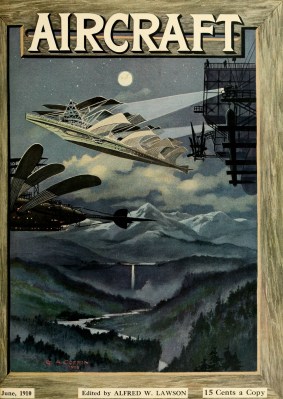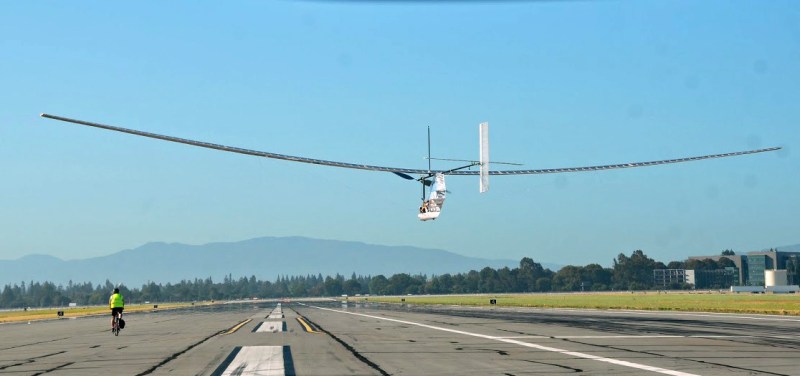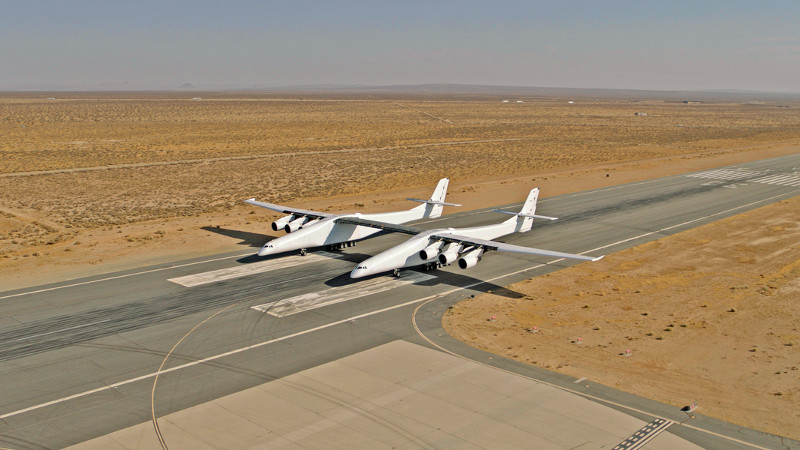We were all glued to our screens for a moment a few weeks ago, watching the Scaled Composites Stratolaunch dual-fuselage space launch platform aircraft make its first flight. The six-engined aircraft represents an impressive technical feat by any standard, and with a wingspan of 385 ft (117 m) and payload weight of 550,000 lb (250 t), is touted as the largest ever flown.
Our own Brian Benchoff took a look at the possibility of hauling more mundane cargo as an alternative (and possibly more popular) use of its lifting capabilities. And in doing so mentioned that “by most measure that matter” this is the largest aircraft ever built. There are several contenders for the title of largest aircraft that depend upon different statistics, so which one really is the largest? Sometimes it’s not as clear as you’d think, but finding out leads us into a fascinating review of some unusual aeronautical engineering.
![The Antonov 225 in flight. Alex Beltyukov [CC BY-SA 3.0]](https://hackaday.com/wp-content/uploads/2019/04/Antonov_An-225_Beltyukov-1.jpg?w=400)
So, back to the Stratolaunch. It has the largest wingspan of any aircraft flown, but is it really the largest aircraft? The answer’s a little complex, and depends on how you classify your aircraft.
What Does Large Even Mean?
Until this month, asking a Hackaday reader what the largest aircraft was would have elicited a straightforward answer. The Antonov AN225 Mriya was produced in the 1980s as the ultimate progression of a string of large Soviet transport aircraft. It was conceived as a transporter for the Soviet space programme and also with an eye for use as an aerial launch platform, and has a distinctive split tailplane to accommodate the turbulence caused by a load such as a Buran spacecraft mounted upon its roof. The Antonov company now has its home in modern-day Ukraine, and the sole completed AN225 now serves as a commercial aircraft traveling the world with the market for extreme-sized air freight all to itself. Its wingspan at 290 ft (88.4 m) leaves it well behind the Stratolauncher, but its 275 ft 7 in (84m) length and 559,580 lb (253.8t) payload capacity both exceed those of the American craft. So the Ukrainians have the larger aircraft. But so do the Americans, so at this point we enter the realm of international rivalries, and reading further into the subject, some pretty fascinating aircraft.

The history of very large fixed-wing aircraft is a long one, with contenders stretching back to the first couple of decades of powered flight. At the time futurologists had visions of aircraft following the same trajectory as ships and becoming ever more massive, so it was natural that a generation of monster aircraft would emerge in the years following the First World War. Flight iconography was all the rage in contemporary design, and being the first to have a contender for the world’s largest aircraft became a source of national pride. Giant aircraft such as Germany’s Dornier Do X seaplane or the Soviet Union’s Tupolev ANT-20 were the last word in aeronautical development, and governments and aircraft manufacturers across the world scrambled to build their own prototype monster craft through the 1930s.
The demands of a global conflict by the end of that decade necessitated series-production heavy bombers and transport aircraft rather than prototype luxury airliners, so the largest aircraft of WWII were fewer in number and saw little action. Probably the most famous of all of them was conceived as a wartime transport but not completed until 1947. The Hughes H4 Hercules, “Spruce Goose” flying boat was conceived as a long-distance transport aircraft for the American military able to move up to 750 troops or two tanks across the Atlantic, and with a 320 ft 11 in (97.54 m) wingspan it comfortably exceeded all large aircraft contenders until the Stratolauncher, and though it has now been surpassed by all measures it remains a genuine holder of the largest aircraft title. Contrary to popular legend it is not made of spruce, instead employing a birch composite for lightness and economy of wartime aluminium use.
Who Are Today’s Contenders?
![The Airbus A380 airliner at its launch. Xeper[CC BY-SA 3.0]](https://hackaday.com/wp-content/uploads/2019/04/1280px-A380_Reveal_1.jpg?w=400)
It’s Really About the Tech

One of the most interesting parts of writing this piece has surprisingly not come from the behemoth aircraft listed above, but from learning about the other largest aircraft, those largest of a particular type. Watching YouTube videos of the Antonov AN-2 for example, the largest mass-produced single-engined biplane, whose unique wing design delivers a capability for seemingly impossibly slow flight. Or the Solar Impulse 2 solar-electric circumnavigation aircraft, which we’re giving the crown of largest electric manned aircraft based on its 71.9 m (236 ft) wingspan but are prepared to be proved wrong by readers with greater knowledge. Sometimes with experimental aircraft it can even be difficult to ascertain which is the largest, we think the DaSH PA with its around 40-metre wingspan is the largest human-powered aircraft, but understandably in that field the designers are more concerned with performance or simply getting airborne in the first place than they are with size records.
Perhaps there is a lesson to be taken from the solar- and human-powered aircraft in all of this. With so many contenders for the title of largest aircraft, should we even be rating these craft on their size alone? They all represent astounding achievements of extreme engineering and material science in their own ways, so not one of them is less worthy of our excitement than any other. Instead we should be keenly looking forwards, because if one organisation, company, or country claims the title of largest aircraft, there is sure to be another exciting craft from another source in the works vying to take away its crown. And that is what keeps us here at Hackaday coming back for more.
Header image, Scaled Composites Stratolauncher, Robert Sullivan [No restrictions]















Let us discount one-off aircraft, those that only one model exist, the Hughes H4, the An-225, the StratoLaunch.
Now you enter the realm of intent. The H4 was intended for mass production, and would have been if it was finished before the war ended.
There are two AN225 airframes, one however was never fitted for flight. I learned that there’s a Chinese company interested in licensing the design too.
Similar to determining whether the Big Boy or Allegheny was the biggest steam locomotive.
I thought Big Boy had another made just like it…
Referring to the model of locomotive. There were I believe 25 Big Boys built and 60 Alleghenies.
Don’t forget the Guppy and the SuperGuppy, pretty crazy aircraft in their day.
Also, don’t be so narrow in the definition of ‘aircraft’, you are talking about airplanes. There are/were many MUCH larger aircraft. The Graf Zeppelin was almost 3x longer than the AN-225. The Hindenburg was even longer (by about 40cm ;) Don’t even get started with ‘by volume’ when you bring the Zeppelins into the discussion. (Of course _useable_ volume is a different question. )
Oh, the humanity..
Once NASA had finished with it, the Super Guppy was used by Airbus as a predecessor to the Beluga transporter.
The authors were fairly specific to powered, fixed wing aircraft. Obviously, there are other large types of aircraft. I’m surprised the AN120 didn’t even get a mention. Easily comparable to the 747, which did in fact see service. I don’t know how many, but I’ve seen them in Kuwait in the early 2000s when we had a large military presence there, the coalition forces were using them for logistics. They are mammoth aircraft, considerably larger than our C-5, another very large aircraft.
In keeping with the theme of “billionaire builds largest aircraft”, it was recently reported that Sergey Brin (Google cofounder) is seeking engineers to move forward on his 656 foot long blimp project. While not quite as large as the German airships, it promises to be the largest aircraft in operation when completed.
You don’t know fun until you are driving past the end of the runway in a Miata when there is a C5 smoking in low to do a touch and go. You suddenly know how the mouse feels when the hawk is around.
The other big plane memory is living in Texas, about 2 miles off the end of the runway for AFB, home of a squadron of B-52G and H models and AWACs. They scrambled all of them early (~9am) one Sunday morning. They had an informal agreement not to train during church hours. When you are awoken by AWACs and BUFF after BUFF until the airfield is empty, you’re pretty sure the End is Near.
I grew up near one of the British USAF bases at the height of the Cold War. We got value from your tax dollars! :)
i am dissapoint by the lack of large helicopters in this article.
Please feed us your favorite helicopter lore and we’ll add it to our kitty of article leads ;-)
tips@hackaday.com
For me, nothing has brought home the scale of really big transport helicopters like the 2002 shootdown of a Mil Mi-26 in Chechnya. 142 passengers! Like a helicopter 737.
Rated capacity is only 90, though. So half a 737.
Exactly the same as a Canadair RJ 900.
Just like, it would be a mistake to think that a VW Microbus can hold as many passengers as a Crown Supercoach. But if they’re hippies, you can just pack them in like sardines, or Russian conscripts.
Nobody would pack a Crown Supercoach or a 737 that full. They’d have bought something cheaper.
At first I was thinking of this ANT aircraft with an interesting history, though not the largest unless maybe flight for the time:
https://en.wikipedia.org/wiki/Tupolev_ANT-25
https://www.historylink.org/File/7208
Cruel regimes when the leadership consists of the best bank robbers. Interesting aircraft and some science however.
https://en.wikipedia.org/wiki/Helicarrier
You’re joking, I suppose…
https://en.wikipedia.org/wiki/Helicarrier
Sorry, if you include fictional crafts that’s nowhere near lthe largest flying machine out there.
es: https://en.wikipedia.org/wiki/GSV_Sleeper_Service
I’ll just put this here…
https://en.wikipedia.org/wiki/Floating_cities_and_islands_in_fiction
More properly:
https://en.wikipedia.org/wiki/Floating_cities_and_islands_in_fiction#Airborne_cities_and_islands
These are all wannabes. Larry Niven knows how to build one.
https://en.wikipedia.org/wiki/Ringworld
As much as I am a fan of Niven’s works, you are comparing apples and grapefruit.
Ringworld hardly qualifies as an aircraft.
What about https://en.wikipedia.org/wiki/Caspian_Sea_Monster
I thought about it, but decided to restrict it to free flying craft rather than ekranoplans. Besides, stubby wings.
How about the Caproni Ca60 with a _total_ wingspan of 370m (886 ft)
https://en.wikipedia.org/wiki/Caproni_Ca.60
Gosh. I hadn’t seen that.
The Caproni Ca60 was featured in Hayao Miyazaki’s 2013 film The Wind Rises. I thought the depiction was an outrageous, whimsical work of fantasy; I was astounded to learn that the Ca60 was a real and (briefly) functional airplane.
The article only discusses airplanes. The largest aircraft ever flown were the LZ 129 Hindenberg and the LZ 130 Graf Zeppelin with a length of 804′ and diameter of 135′.
I’ve had the privilege of being in the physical presence of the Spruce Goose. I was wandering through the Evergreen Aviation Museum, knowing it was there, and looking forward to seeing it . . . and wondering where it was. Surely an airplane of that size would be hard to miss?
Suddenly, my perspective shifted and I realized that I was in fact standing next to and under it. It’s *so big* that until that moment, my brain had subconsciously flagged it as “architecture” instead of “vehicle” and I’d been unknowingly ignoring it. It’s so big that it can be underlooked.
I don’t think I’ll ever forget that moment.
No mention of the Convair B-36 Peacemaker (230’0″)which had the largest wingspan of any bomber in the USAF.